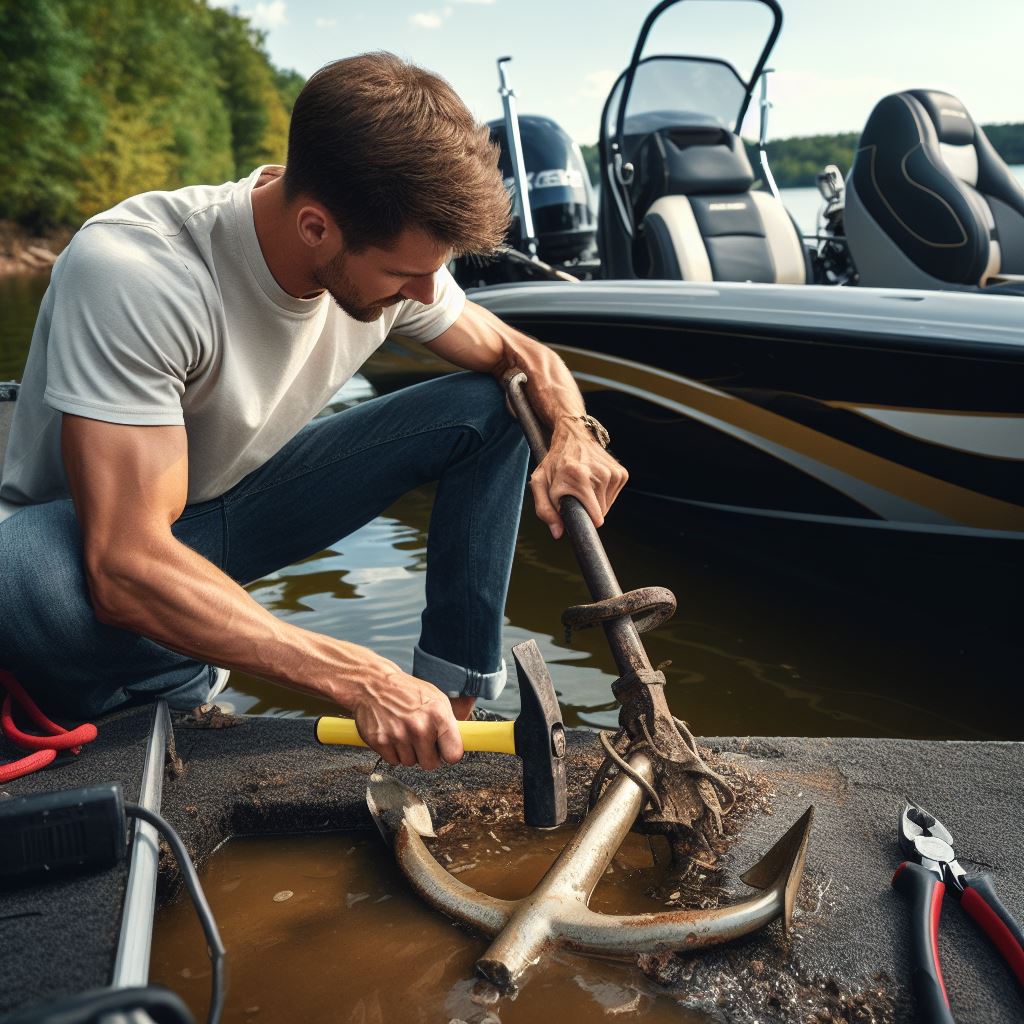Introduction
Welcome to our guide on anchor repair! If you own a boat or any other watercraft, you know how important a sturdy anchor is for keeping your vessel secure. However, over time, anchors can become damaged due to wear and tear or accidental mishaps. In this article, we will walk you through the signs of a damaged anchor, the essential tools you’ll need for repair, and a step-by-step guide on how to fix it yourself. We’ll also provide some valuable tips on preventing future anchor damage. So, let’s dive in and ensure your anchor is in top-notch condition!
Signs of a Damaged Anchor
So, you’re out on your boat, enjoying a beautiful day on the water, when suddenly you notice something unsettling – your anchor doesn’t seem to be working properly. Whether it’s not holding your boat in place or it’s showing visible signs of wear and tear, a damaged anchor can be a cause for concern. But how do you know if your anchor is truly damaged? Let’s take a look at some common signs:
- Weak Holding Power: If your anchor is struggling to hold your boat in place, even in calm conditions, it may be a sign of damage. This could indicate that the anchor’s flukes (the pointed parts that dig into the seabed) are bent or broken, reducing their ability to grip the bottom.
- Rust and Corrosion: Over time, anchors can become rusty and corroded, especially if they are made of steel or iron. If you notice significant rust or corrosion on your anchor, it’s a clear indication that it may need to be repaired or replaced.
- Worn or Frayed Rope: The rope or chain that connects your anchor to your boat is just as important as the anchor itself. If you notice any fraying, kinks, or weak spots in the rope, it’s a sign that it’s time for a new anchor line.
- Damaged Flukes: Take a close look at the flukes of your anchor. Are there any cracks, chips, or breaks? Any damage to the flukes can compromise their ability to dig into the seabed and hold your boat in place.
If you notice any of these signs, it’s important to address the issue promptly. Ignoring a damaged anchor can lead to dangerous situations on the water. But don’t worry, we’ve got you covered with a step-by-step guide for DIY anchor repair coming up next!
Essential Tools for Anchor Repair
When it comes to repairing a damaged anchor, having the right tools can make all the difference. Here are some essential tools you’ll need to have on hand before you begin:
- Wrench or pliers: These will be necessary for loosening and tightening bolts or screws.
- Wire brush: A wire brush is great for removing rust and debris from the anchor.
- Epoxy resin: This adhesive will help to strengthen and stabilize any cracks or breaks in the anchor.
- Sandpaper: Sandpaper will be useful for smoothing out rough edges after repairs are made.
- Paint or sealant: Once the anchor is repaired, applying a fresh coat of paint or sealant will help to protect it from further damage.
- Safety goggles and gloves: It’s important to protect yourself while working with tools and chemicals, so be sure to wear safety goggles and gloves.
By having these essential tools on hand, you’ll be well-equipped to tackle any anchor repair job that comes your way. Remember, safety should always be your top priority, so be sure to use caution and follow any additional safety guidelines provided by the manufacturer.
Step-By-Step Guide for DIY Anchor Repair
Repairing a damaged anchor doesn’t have to be a daunting task. With the right tools and a little know-how, you can easily fix it yourself. Here’s a step-by-step guide to help you get started:
- Assess the damage: Before you begin, carefully examine the anchor to determine the extent of the damage. Look for any cracks, bends, or missing parts.
- Gather the necessary tools: To repair your anchor, you’ll need a few essential tools, including a torch, a hammer, pliers, a file, and a vice.
- Heat the damaged area: If your anchor is bent, you can use a torch to heat the affected area until it turns cherry red. This will make it easier to straighten the anchor.
- Straighten the anchor: Using pliers or a vice, carefully straighten the heated portion of the anchor. Be gentle and take your time to avoid causing further damage.
- File away any rough edges: After straightening the anchor, use a file to smooth out any rough edges or burrs. This will prevent any potential snags or damage to your boat’s hull.
- Inspect and test: Once you’ve completed the repair, thoroughly inspect the anchor to ensure it is in good working condition. Test it by dropping it into shallow water and checking for any signs of weakness or further damage.
Remember, safety should always be your top priority when working with tools and equipment. If you’re unsure about any step of the repair process, it’s best to consult a professional.
Common Mistakes to Avoid
When it comes to repairing a damaged anchor, it’s important to approach the task with caution and care. Here are some common mistakes to avoid:
- Ignoring the problem: Many boat owners make the mistake of ignoring a damaged anchor, thinking it’s not a big deal. However, even a small crack or bend can compromise the anchor’s functionality and put your boat at risk. It’s important to address any signs of damage as soon as possible.
- Using the wrong tools: Using improper tools for anchor repair can lead to further damage or ineffective repairs. It’s essential to have the right tools on hand, such as a grinder, epoxy, and a torque wrench, to ensure a proper and long-lasting fix.
- Rushing the repair process: Anchor repair requires patience and attention to detail. Rushing through the repair process can result in subpar repairs that won’t hold up over time. Take your time, follow the step-by-step guide, and ensure each repair is done correctly.
- Overlooking hidden damage: When repairing an anchor, it’s important to thoroughly inspect the entire anchor for any hidden damage. Sometimes, the visible damage is just the tip of the iceberg. Look for cracks, rust, or other signs of wear and tear that may not be immediately obvious.
- Not seeking professional help when needed: While DIY repairs can be cost-effective and rewarding, there are instances where professional help is necessary. If you’re unsure about the extent of the damage or how to properly repair it, it’s best to consult a marine professional who can provide expert advice and assistance.
By avoiding these common mistakes, you’ll be well on your way to successfully repairing your anchor and ensuring the safety and reliability of your boat.
Tips for Preventing Future Anchor Damage
Now that you’ve successfully repaired your damaged anchor, it’s important to take steps to prevent future damage. Here are some helpful tips to keep your anchor in tip-top shape:
- Regular inspections: Make it a habit to inspect your anchor regularly for any signs of wear and tear. Look out for rust, cracks, or any other damage that could weaken its structure. Catching these issues early on can prevent further damage.
- Proper storage: When not in use, store your anchor in a dry and clean environment. Moisture can lead to rust, so it’s important to keep it in a place where it won’t get wet or damp.
- Appropriate cleaning: Give your anchor a thorough cleaning after each use. Use fresh water and a mild detergent to remove any salt or debris that may have accumulated. This will help prevent corrosion and keep your anchor working smoothly.
- Secure anchoring: When anchoring your boat, make sure to choose a suitable spot with proper bottom conditions. Avoid areas with rocky or uneven surfaces that could potentially damage your anchor.
- Proper sizing and weight: Ensure that you’re using the right size and weight anchor for your boat. Using an anchor that is too small or too light for your vessel can result in poor holding power and increased risk of damage.
- Anchor chain maintenance: Regularly inspect and maintain your anchor chain. Look for signs of corrosion or weak links, and replace any damaged sections promptly.
- Seek professional advice: If you’re unsure about any aspect of anchor maintenance or repair, don’t hesitate to consult with a professional. They can provide expert guidance and ensure that you’re taking the necessary steps to protect your anchor and boat.
By following these tips, you’ll be able to prolong the lifespan of your anchor and enjoy worry-free boating adventures. Remember, prevention is key when it comes to anchor damage!
Conclusion
Repairing a damaged anchor is an essential task for any boat owner or enthusiast. By following the step-by-step guide and using the essential tools mentioned in this article, you can easily fix a damaged anchor and ensure its longevity.
Remember to carefully inspect your anchor regularly for any signs of damage, such as rust or bent flukes. By catching these issues early on, you can prevent further damage and ensure the anchor’s effectiveness in holding your boat securely in place.
When repairing the anchor, be cautious and avoid common mistakes such as using incorrect materials or not properly tightening the bolts. Taking your time and following the instructions will ensure a successful repair.
Lastly, it is important to take preventive measures to avoid future anchor damage. This includes rinsing the anchor with freshwater after each use in saltwater, storing it properly in a dry and secure location when not in use, and regularly lubricating any moving parts.
By properly maintaining and repairing your anchor, you can have peace of mind knowing that it will consistently perform its job of keeping your boat safe and secure. So don’t neglect your anchor – give it the care and attention it deserves!


